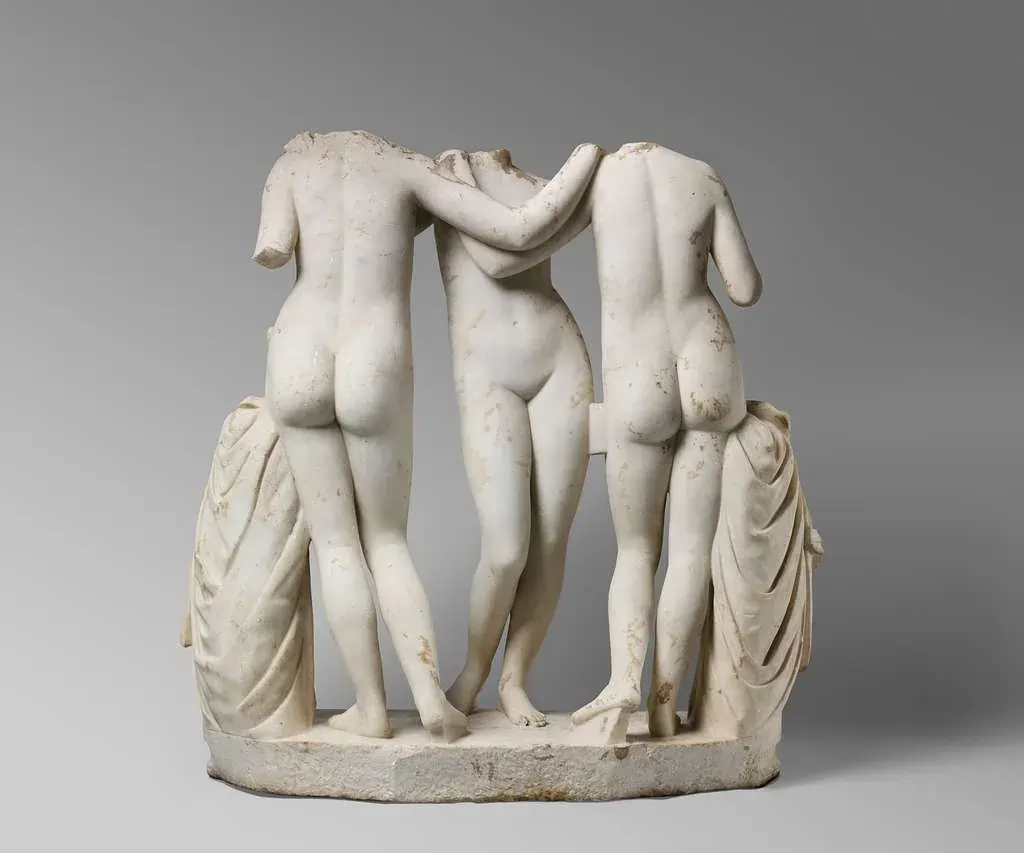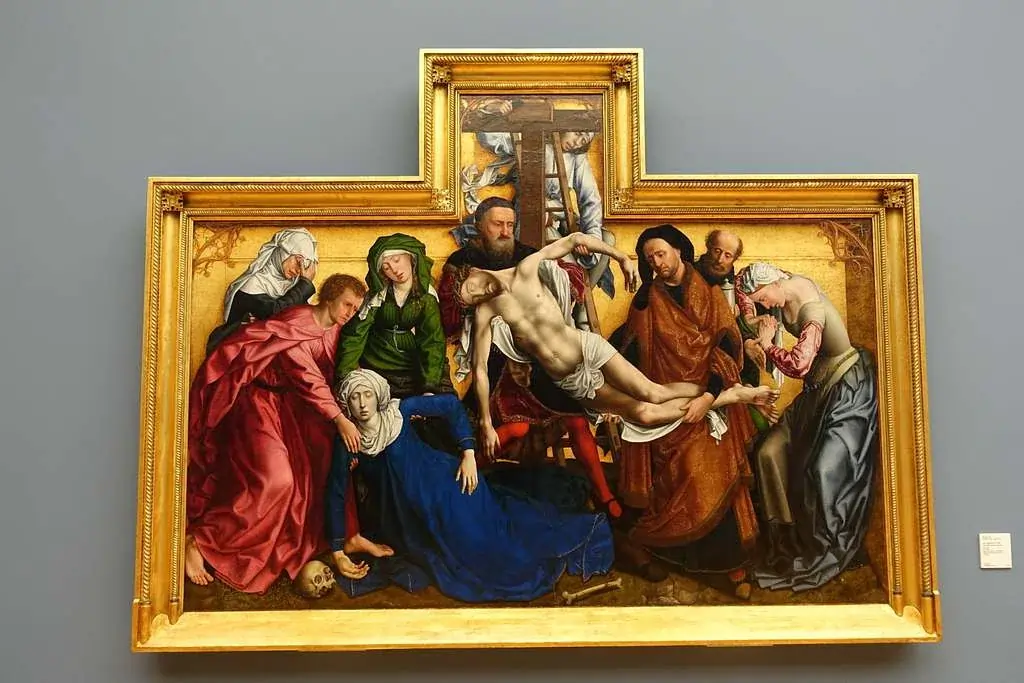Gazing at a marble sculpture can take us on a journey spanning centuries of accomplishments, by humans; few creations embody this enduring elegance beautifully as the marble statue ensemble depicting the Three Graces. A work that has mesmerized spectators for ages, with its graceful lines and intricate features.
We are captivated by this marble statue not for its masterful craftsmanship but also, for the narrative it conveys. The trio of figures engaged in their timeless dance symbolizes the blend of gracefulness and happiness found in ancient myths.
In this piece of writing with you today will delve into the captivating tale of this stunning sculpture masterpiece with you all here with me now on this journey we’re embarking on as we uncover its age old beginnings and marvel, at the exquisite skill and artistry that infused it with life while also shedding light on the contemporary conservation initiatives aimed at safeguarding this gem for the enjoyment and wonderment of generations yet to come.
Table of Contents
ToggleThe Origins and Discovery of the Three Graces
The Three Graces are said to have originated from Greek mythology, which shows that they as were the born daughters of Zeus and Eurynome, a sea nymph. When I research more about them, I am hooked by the fact that these three goddesses, Aglaia, Euphrosyne and Thalia are personifications of the blithe, the joy and the prosperity respectively in the ancient culture.
Ancient Greek mythological roots
These enchanting deities bestowed unique gifts upon humanity:
- Aglaia brought beauty and radiance
- Euphrosyne offered the gift of mirth and joy
- Thalia represented abundance and flowering youth
The Graces were attendants to Aphrodite and their duties included choreography of dances and being a part of festivals. I have found out that their impact went well beyond the physical appearance – they symbolized the concept of giving, receiving, and paying back for favors, which the ancient Roman philosopher Seneca defined as the ‘chief bond of human society’.
Roman adaptation and significance
When the Romans adopted these gods they called them Gratiae. It is also quite fascinating to notice that it was during this time that these symbols enjoyed immense popularity and people used them in a variety of objects such as mirrors and sarcophagi. The Romans kept the main characteristics of the Italic goddesses and adjusted them to suit the Roman concept of beauty and community order.
Archaeological discovery in Rome
The marble statue group that is displayed today was found below the Roman streets in the year 1892, near the Forum of Nerva and Vespasian’s Temple of Peace. This second century A.D Roman marble sculpture is the copy of a Greek work done in the second century B.C. This particular statue group was found in 1892 which was five meters below the level of via Torre dei Conti 15. This find of this particular statue group was one of the remarkable in the archaeological history as it was acquired by Joachim Ferroni and got much attention from the scholars.
Masterful Marble Craftsmanship
The intricate artistry displayed in the Three Graces sculpture leaves me in awe of the talent needed to carve marble into realistic forms. I’d like to talk about what sets this masterpiece from the rest.
Sculptural techniques and details
It is interesting how Canova and his team worked on this piece. While Canova’s assistants laid down the general shape of the marble, Canova himself did the last touches to give it that soft flesh-like look. The sculpture is made of white marble and was created from a single block of stone which is a clear demonstration of the artist’s talent in seeing the final work from the piece of stone.
Material selection and properties
The choice of material was crucial to the sculpture’s success. I’ve learned that marble’s unique properties make it ideal for detailed sculptural work:
- Natural veins and subtle color variations add visual texture
- Semi-opaque surface creates an ethereal quality
- Remarkable potential for simultaneously showing reflection, translucence, and opacity
The sculptor specifically chose white Carrara marble for this piece, changing from the veined marble used in earlier versions. This decision proved crucial, as the pure white marble perfectly captured the delicate nature of the figures.
Preservation challenges and solutions
Through my studies and investigations I’ve come to realize that safeguarding these remarkable works poses distinct obstacles Marble might seem robust at glance but is remarkably sensitive, to factors The primary difficulties, in preservation encompass;
The stone is quite sensitive, to substances and elements. We now know that even the oils, on our hands can lead to staining—a reason why current conservation practices emphasize cleaning methods and environmental management. Routine upkeep simply involves dusting without using chemicals that might harm the stones appearance and integrity.
I’m intrigued by how contemporary conservators tackle these obstacles in such a way by employing methods to remove stains and safeguard the marble from harm caused by the environment to ensure that this extraordinary piece remains captivating for generations to come.
Anatomical Precision and Composition
On looking at the marble statue group of the Three Graces closely, one is first struck by the amount of detail that has gone into the representation of muscle and bone. This is evident in every nook and cranny of these figures proving that the artist had a very good grasp of human anatomy.
Classical proportions and balance
The way the artist has portrayed the figures with a blend of perfection and realism is truly captivating to me The graceful folds of the clothing highlight their body shapes, with precision What intrigues me the most is how slight differences in their poses bring out characteristics, in each Grace yet they all come together cohesively.
Movement and gesture analysis
The piece evokes a captivating feeling of motion. Calmness to me as I look at the arrangement of the individuals in a casually intertwined circle that invites spectators to move around the cluster to admire it from all angles. What truly catches my attention is how each subtle movement unveils perspectives of the tender interaction, between the figures.
Key compositional elements that catch my eye:
- The unified circular arrangement
- The delicate balance between the three heads
- The interconnected hand positions
- The harmonious flow of drapery
Spatial relationships between figures
The way the three figures are positioned in relation, to each other is incredibly intriguing to me! I find it captivating how they all seem to be standing on a base and their poses hint at a mix of dancing and being connected to one another at the time. I believe that the sculpture has achieved a flawless harmony. The figures seem to blend into one another as they embrace each other with their linked hands and the scarf that connects them further enhances this unity. It’s not about looking good either; this arrangement sparks a visual conversation that highlights how inseparable they are, from each other.
The way light and shadow interact, on the sculptures surface brings a layer to the artworks look and feel. It makes for a captivating visual journey that shifts as you change your viewpoint.
Technical Conservation Journey
It is interesting to me to follow the process of maintaining this beautiful marble statue group. I am especially interested to know how the Three Graces got their new home in 1817 at Woburn Abbey. As for the latter, it is significant that Canova himself provided the recommendations on the ideal lighting and placement of his creation in 1815.
Historical restoration efforts
The use of the statue was initially quite specific as it was placed in a very grand setting. I have found out that it was placed which in was a designed new as building a called tall, the narrow Temple room of with the Graces, overhead skylight. The most fascinating is fact the fact that the sculpture was placed on what was believed to be an ancient marble base, which was actually from the 18th century, and could be rotated for better viewing.
Modern preservation techniques
Today, I see how preserving this masterpiece requires careful attention. Modern conservation methods include:
- Regular gentle cleaning with soft, damp cloths
- Protection from acidic substances
- Application of specialized marble sealants
- Periodic professional inspection for wear and damage
Current display considerations
The statue embarked on a chapter when the Victoria & Albert Museum and the National Gallery of Scotland acquired it together in 1994, which I find fascinating how they blend display methods, with preservation requirements for public viewing accessibilities impressively well! The current exhibition stays true, to Canova’s vision in terms of lighting while adapting to conservation practices seamlessly.
The thing that stands out to me the most is how the preservation difficulties of the statue reflect its intricacy. The cleaning procedure must be consistent, on all parts of the surface. I have observed how conservators meticulously regulate temperature and humidity to safeguard this marble artwork.
Conclusion
Today as I stand in front of the Three Graces sculpture I am amazed, by how this stunning piece mesmerizes people, like it did ages ago. Exploring its past unveils a blend of mythological narratives and superb artistic skills brought to existence through exceptional marble workmanship.
This incredible collection of sculptures imparts insights, on safeguarding heritage and artistic heritage for posterity’s sake. The precise chiseling details, crafted poses and devoted preservation initiatives all play a role in its timeless allure. According to my studies, present day conservation practices straying from those of the past yet uphold an objective. Safeguarding this artwork, for future epochs.
The sculpture known as The Three Graces is not a piece of art—it represents the artistic abilities of humanity and serves as a timeless symbol of artistic excellence, through its classical proportions and precise anatomical details that blend together in perfect harmony.
FAQs
Q1. Who created the marble statue group of the Three Graces? The marble statue group of the Three Graces is a Roman copy of an earlier Greek work from the second century B.C. The specific Roman sculptor is unknown, but the statue was discovered in Rome in 1892.
Q2. What do the Three Graces represent in mythology? In Greek mythology, the Three Graces – Aglaia, Euphrosyne, and Thalia – represent beauty, charm, and joy. They were believed to bestow gifts upon humanity, including radiance, mirth, and abundance.
Q3. How was the marble statue of the Three Graces discovered? The statue was unearthed in 1892 during an archaeological excavation in Rome. It was found five meters below street level near the ancient Forum of Nerva and Vespasian’s Temple of Peace.
Q4. What makes the craftsmanship of the Three Graces statue exceptional? The statue showcases remarkable anatomical precision and is carved from a single slab of white Carrara marble. The sculptor’s skill is evident in the delicate rendering of flesh, and flowing drapery.



